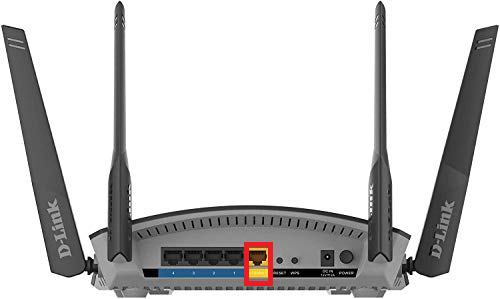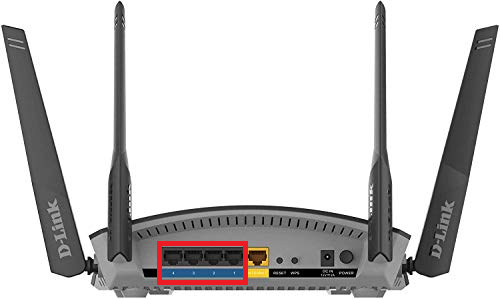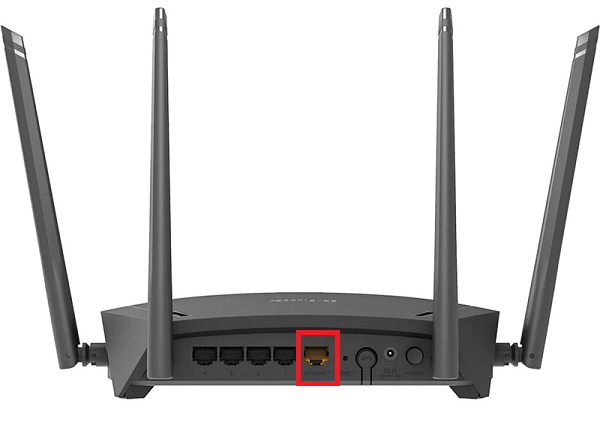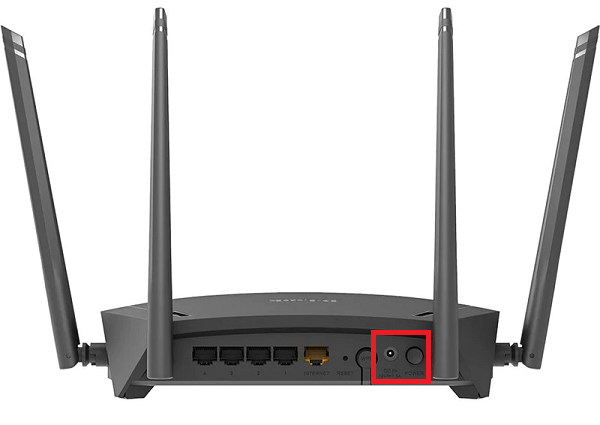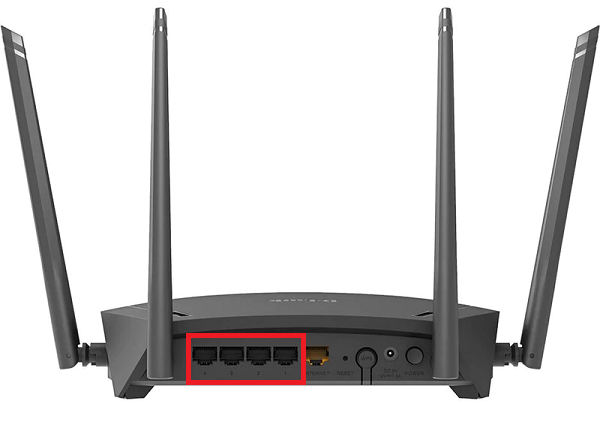You'll need to plug in your D-Link DIR-1960 Exo AC1900 Smart Mesh Wi-Fi Router and change some settings to get it working with TPG nbn HFC.
-
First, make sure you’ve got a message from us asking you to plug in your nbn modem. We need to get your connection ready on our side before you plug in.
-
Find your phone wall socket and nbn Connection Box (NCB) – you probably already have a modem plugged in from your last internet service. Unplug any old modem from the NCB and power outlet.
If your NCB is missing, please call us on 1300 023 575. -
Use the Ethernet cable to connect your modem’s yellow Internet port to your NCB's UNI-D1 port or 2.5G port.
-
Use the power cable to connect the Power port on your modem to a power outlet. Press your modem's Power button to turn it on.
- o connect devices to the WiFi, you'll find the default WiFi name and password on your modem's barcode sticker.
- If you have extra Ethernet cables, you can connect up to 4 devices to your modem’s LAN ports.
-
Open your web browser and go to: https://192.168.1.1 or https://dlinkrouter.local
-
Log in with the default password found on your modem's barcode sticker. If you have a custom password, use that instead.
-
Select Settings, then Internet.
-
For My Internet Connection is, select PPPoE.
-
Enter your TPG username and password.
Your TPG username can be found in emails from us about your TPG order. If you've forgotten your password, reset your password. -
If you have a bundled nbn & phone plan: Select Internet Settings > VLAN. Turn on Triple Play and Priority ID. For Internet VLAN ID, enter 2 and for Priority ID, enter 0.
- Hit Save and you're good to go.
Can't get online? Call us on 1300 997 271 and we'll help you.
You'll need to plug in your D-Link DIR-1960 Exo AC1900 Smart Mesh Wi-Fi Router and change some settings to get it working with TPG nbn FTTC.
- First, make sure you’ve got a message from us asking you to plug in your nbn modem. We need to get your connection ready on our side before you plug in.
- Find your phone wall socket and nbn Connection Box (NCB) – you probably already have a modem plugged in from your last internet service. Unplug any old modem from the NCB and power outlet.
If your NCB is missing, please call us on 1300 023 575. -
Use the Ethernet cable to connect your modem’s yellow Internet port to your NCB's yellow Gateway port.
-
Use the power cable to connect the Power port on your modem to a power outlet. Press the modem's Power button to turn it on.
- To connect devices to the WiFi, you'll find the default WiFi name and password on your modem's barcode sticker.
- If you have extra Ethernet cables, you can connect up to 4 devices to your modem’s LAN ports.
-
Open your web browser and go to: https://192.168.1.1 or https://dlinkrouter.local
-
Log in with the default password found on your modem's barcode sticker. If you have a custom password, use that instead.
-
Select Settings, then Internet.
-
Set My Internet Connection is to PPPoE.
-
Enter your TPG username and password.
Your TPG username can be found in emails from us about your TPG order. If you've forgotten your password, reset your password. -
If you have a bundled nbn & phone plan: Go to Internet Settings > VLAN. Enable Triple Play Status and Priority ID. For Internet VLAN ID, enter 2 and for Priority ID, enter 0.
-
Hit Save and you're good to go.
Can't get online? Call us on 1300 997 271 and we'll help you.
You'll need to plug in your D-Link DIR-1960 Exo AC1900 Smart Mesh Wi-Fi Router and change some settings to get it working with TPG nbn FTTP.
-
First, make sure you’ve got a message from us asking you to plug in your nbn modem. We need to get your connection ready on our side before you plug in.
-
Find your nbn Connection Box (NCB) – this is usually installed on the inside of an exterior wall in your home, sometimes in the garage. Unplug any old modem from the nbn Connection Box and power outlet.
-
Use the Ethernet cable to connect your modem's yellow Internet port to your NCB's UNI-D1 port.
The message from us will tell you if you need to use a different UNI-D port. -
Use the power cable to connect the Power port on your modem to a power outlet. Press your modem's Power button to turn it on.
- To connect devices to the WiFi, you'll find the default WiFi name and password on your modem's barcode sticker.
- If you have an Ethernet cable, you can connect a device to your modem’s Ethernet port.
-
Open your web browser and go to: https://192.168.1.1 or https://dlinkrouter.local
-
Log in with the default password found on your modem's barcode sticker. If you have a custom password, use that instead.
-
Hit Settings, then Internet
-
Set My Internet Connection is to PPPoE.
-
Enter your TPG username and password.
Your TPG username can be found in emails from us about your TPG order. If you've forgotten your password, reset your password. -
Hit Save and you're good to go.
Can't get online? Call us on 1300 997 271 and we'll help you.
You'll need to plug in your D-Link DIR-1750 AC1750 Gigabit Wi-Fi Router and change some settings to get it working with TPG nbn HFC.
-
First, make sure you’ve got a message from us asking you to plug in your nbn modem. We need to get your connection ready on our side before you plug in.
-
Find your phone wall socket and nbn Connection Box (NCB) – you probably already have a modem plugged in from your last internet service. Unplug any old modem from the NCB and power outlet.
If your NCB is missing, please call us on 1300 023 575. -
Use the Ethernet cable to connect your modem’s yellow Internet port to your NCB's UNI-D1 port or 2.5G port.
-
Use the power cable to connect the Power port on your modem to a power outlet. Press your modem's Power button to turn it on.
- To connect devices to the WiFi, you'll find the default WiFi name and password on your modem's barcode sticker.
- If you have extra Ethernet cables, you can connect up to 4 devices to your modem’s Ethernet ports.
-
Open your web browser and go to: https://192.168.1.1 or https://dlinkrouter.local
-
Log in with the default password found on your modem's barcode sticker. If you have a custom password, use that instead.
-
Select Settings, then Internet.
-
For My Internet Connection is, select PPPoE.
-
Enter your TPG username and password.
Your TPG username can be found in emails from us about your TPG order. If you've forgotten your password, reset your password. -
Hit Save.
-
If you have a bundled nbn & phone plan: Select Internet Settings > VLAN. Turn on Triple Play and VoIP VLAN. For Internet VLAN ID, enter 2 and for Priority ID, enter 0.
- Hit Save and you're good to go.
Can't get online? Call us on 1300 997 271 and we'll help you.
You'll need to plug in your D-Link DIR-1750 AC1750 Gigabit Wi-Fi Router and change some settings to get it working with TPG nbn FTTC.
- First, make sure you’ve got a message from us asking you to plug in your nbn modem. We need to get your connection ready on our side before you plug in.
- Find your phone wall socket and nbn Connection Box (NCB) – you probably already have a modem plugged in from your last internet service. Unplug any old modem from the NCB and power outlet.
If your NCB is missing, please call us on 1300 023 575. -
Use the Ethernet cable to connect your modem’s yellow Internet port to your NCB's yellow Gateway port.
-
Use the power cable to connect the Power port on your modem to a power outlet. Press the modem's Power button to turn it on.
- To connect devices to the WiFi, you'll find the default WiFi name and password on your modem's barcode sticker.
- If you have extra Ethernet cables, you can connect up to 4 devices to your modem’s LAN ports.
-
Open your web browser and go to: https://192.168.1.1 or https://dlinkrouter.local
-
Log in with the default password found on your modem's barcode sticker. If you have a custom password, use that instead.
-
Select Settings, then Internet.
-
Set My Internet Connection is to PPPoE.
-
Enter your TPG username and password.
Your TPG username can be found in emails from us about your TPG order. If you've forgotten your password, reset your password. -
Hit Save.
-
If you have a bundled nbn & phone plan: Go to Internet Settings > VLAN. Enable Triple Play Status and Priority ID. For Internet VLAN ID, enter 2 and for Priority ID, enter 0.
-
Hit Save and you're good to go.
Can't get online? Call us on 1300 997 271 and we'll help you.
You'll need to plug in your D-Link DIR-1750 AC1750 Gigabit Wi-Fi Router and change some settings to get it working with TPG nbn FTTP.
-
First, make sure you’ve got a message from us asking you to plug in your nbn modem. We need to get your connection ready on our side before you plug in.
-
Find your nbn Connection Box (NCB) – this is usually installed on the inside of an exterior wall in your home, sometimes in the garage. Unplug any old modem from the nbn Connection Box and power outlet.
-
Use the Ethernet cable to connect your modem's yellow Internet port to your NCB's UNI-D1 port.
The message from us will tell you if you need to use a different UNI-D port. -
Use the power cable to connect the Power port on your modem to a power outlet. Press your modem's Power button to turn it on.
- To connect devices to the WiFi, you'll find the default WiFi name and password on your modem's barcode sticker.
- If you have extra Ethernet cables, you can connect up to 4 devices to your modem’s black Ethernet ports.
-
Open your web browser and go to: https://192.168.1.1 or https://dlinkrouter.local
-
Log in with the default password on your modem's barcode sticker. If you have a custompassword, use that instead.
-
Hit Settings, then Internet
-
Set My Internet Connection is to PPPoE.
-
Enter your TPG username and password.
Your TPG username can be found in emails from us about your TPG order. If you've forgotten your password, reset your password. -
Hit Save and you're good to go.
Can't get online? Call us on 1300 997 271 and we'll help you.
Please select a topic to view the guide:
- Call Park Retrieve
- Call Transfer
- Global Address Book
- Call Forward
- Directory
- Auto Attendant
- Schedules and Events
- Hunt Group
- Add audio to a Queue
- Music on Hold
- Speed Dial 8
- Busy Lamp Field
- Voicemail Passcode
Before calling TPG, we recommend checking if there is an NBN network outage affecting your area.
| nternet | |
|---|---|
| NBN | |
| Current | |
| Last 24 Hours | |
| Planned Maintenance | |
| FTTB | |
| Current | |
| Last 24 Hours | |
| Planned Maintenance | |
| ADSL | |
| Current | |
| Last 24 Hours | |
| Planned Maintenance | |
| Off-net ADSL | |
| Current | |
| Last 24 Hours | |
| Planned Maintenance | |
| Home Wireless / 4G / 5G | |
| Check mobile data and fixed wireless status | |
| Mobile | |
|---|---|
| Mobile | |
| Current | |
| Last 24 Hours | |
| Planned Maintenance | |
| Mobile Broadband | |
| Current | |
| Last 24 Hours | |
| Planned Maintenance | |
| Phone | |
|---|---|
| Home Phone | |
| Current | |
| Last 24 Hours | |
| Planned Maintenance | |
| VoIP | |
| Current | |
| Last 24 Hours | |
| Planned Maintenance | |
| Current | |
| Last 24 Hours | |
| Planned Maintenance | |
| Others | |
|---|---|
| Web Site Hosting | |
| Current | |
| Last 24 Hours | |
| Planned Maintenance | |
| External Links | |
| Current | |
| Last 24 Hours | |
| Planned Maintenance | |
| Games | |
| Current | |
| Last 24 Hours | |
| Planned Maintenance | |
| Other | |
| Current | |
| Last 24 Hours | |
| Planned Maintenance | |
Internet
| Service | Current | Last 24 Hours | Planned Maintenance |
|---|---|---|---|
| NBN | |||
| FTTB | |||
| ADSL | |||
| Off-Net ADSL |
Mobile
| Service | Current | Last 24 Hours | Planned Maintenance |
|---|---|---|---|
| Mobile | |||
| Mobile Broadband |
Phone
| Service | Current | Last 24 Hours | Planned Maintenance |
|---|---|---|---|
| Home Phone | |||
| VOIP |
| Service | Current | Last 24 Hours | Planned Maintenance |
|---|---|---|---|
Others
| Service | Current | Last 24 Hours | Planned Maintenance |
|---|---|---|---|
| Web Site Hosting | |||
| External Links | |||
| Games | |||
| Other |
